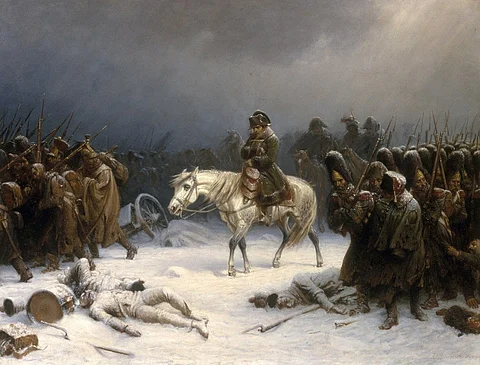

A new study suggests that Napoleon's Grand Armee perished during the 1812 retreat from Moscow due to a combination of fatigue, cold, and diseases like paratyphoid fever and louse-borne relapsing fever.
Researchers sequenced ancient DNA from soldiers' teeth, identifying pathogens that contributed to the army's collapse, challenging previous assumptions about typhus being the main cause.
Paratyphoid Fever and Relapsing Fever, both bacterial infections, may have been responsible for the collapse of Napoleon Bonaparte’s Grand Armee during its retreat from Russia during the terrible winter of 1812, according to scientists.
Scientists from the Institut Pasteur and partner institutions recovered and sequenced ancient DNA from the teeth of 13 soldiers from Vilinus in today’s Lithuania who, based on historical records, likely died from infectious diseases.
They aimed to identify the pathogens responsible for their deaths.
Their results confirmed the presence of Salmonella enterica subsp enterica belonging to the lineage Para C, the causative agent of paratyphoid fever and Borrelia recurrentis, responsible for relapsing fever transmitted by body lice.
Paratyphoid fever, also known as paratyphoid, is a form of enteric fever, similar to typhoid fever, and is characterised by prolonged fever, headache, and malaise. It is often acquired through contaminated food or water, particularly in developing countries.
Louse-borne relapsing fever is a bacterial infection transmitted by body lice, characterised by recurring episodes of fever, chills, and other symptoms. It is typically found in areas of poverty and poor sanitation.
The scientists were not able to detect Rickettsia prowazekii (the agent of typhus) and Bartonella quintana (the cause of trench fever), which had previously been associated with this deadly event.
In the June of 1812, Napoleon I, the French emperor, assembled a military force of about 500,000 to 600,000 soldiers to invade Russia.
The Grand Armee assembled by the emperor, arrived in Moscow without decisively defeating the Russian army. The Russians though burned their capital and their food stocks leaving the French without food, with winter fast approaching.
The Grand Armee began its retreat from October 19. It was to last till December 14, 1812. According to historians, it wasn’t the harassment from the Russian army that claimed the lives of about 300,000 men, but rather the harsh cold of the Russian winter, coupled with hunger and diseases.
Doctors such as J R L de Kirckhoff authored a book where he documented the prevalence of typhus, diarrhea, dysentery, fevers, pneumonia, and jaundice as the ailments that took the lives of the Napoleonic soldiers.
Later studies held typhus to be mainly responsible for the decimation of the Grand Armee, given its association with armies.
This assumption was strengthened by the discovery of body lice — the main vector of typhus — among the remains of Napoleonic soldiers who perished during the Great Retreat from Russia in December 1812 in Vilnius, Lithuania.
“Several years later, another study successfully detected Anelloviridae viral ancient DNA (aDNA) in Napoleonic soldiers recovered in Kaliningrad in 1812, but these viruses are ubiquitous and asymptomatic in human populations, and therefore unrelated to the fatal fate of these soldiers.” the authors wrote.
They added that they used state-of-the-art aDNA methodologies to reanalyse samples from Napoleonic soldiers who died in Vilnius and identified pathogen-specific genetic material, providing direct evidence of infectious agents that may have contributed to the army’s collapse
They did accept the limitations of their study.
“Our study thus provides the first direct evidence that paratyphoid fever contributed to the deaths of Napoleonic soldiers during their catastrophic retreat from Russia. However, the limited number of samples that were processed (n=13), in relation to the large number of reported bodies in this site (over 3000), is not sufficient evidence to conclude that this pathogen alone contributed to all the deaths at the site. Considering the extreme and harsh conditions that characterized this retreat, the presence of multiple overlapping infections is highly plausible. Typhus has long been reported to have affected Russia in this period, but the existing evidence remains inconclusive to support a role of this disease in the devastation of Napoleon’s Army,” they wrote.
The authors concluded that in light of their results, “a reasonable scenario for the deaths of these soldiers would be a combination of fatigue, cold, and several diseases, including paratyphoid fever and louse-borne relapsing fever.”
While not necessarily fatal, the louse borne relapsing fever could significantly weaken an already exhausted individual.
They added that their work demonstrated that “high-throughput sequencing of ancient DNA is a powerful approach for investigating historical disease dynamics and underscores its capacity to accurately identify ancient pathogens, even when only limited genomic data are available.”
The study, Paratyphoid Fever and Relapsing Fever in 1812 Napoleon's Devastated Army, has been published on the pre-print server bioRxiv.